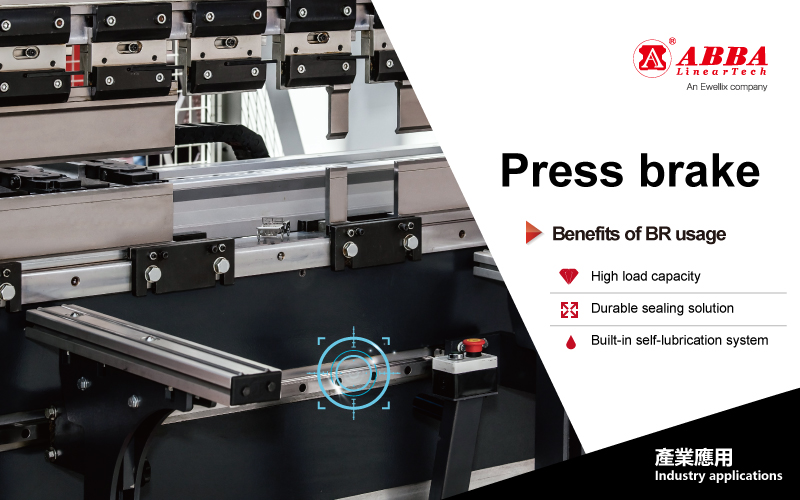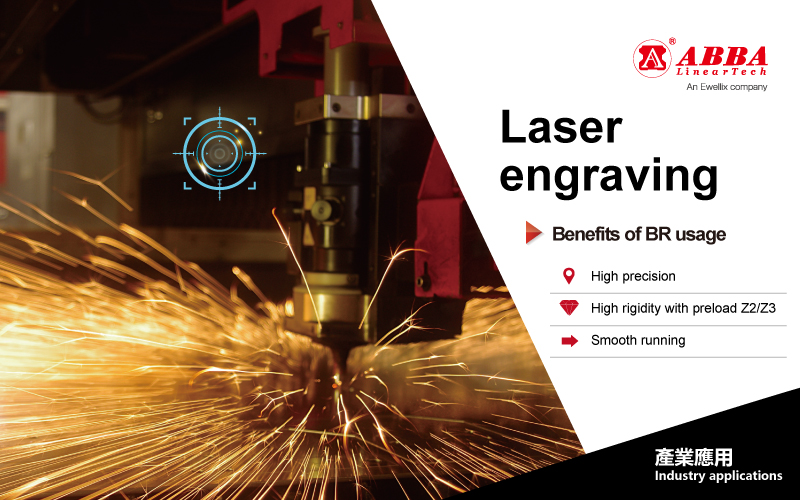ABBA LINEAR TECH CO., LTD.
Revolutionizing Metal Forming with ABBA Linear Guides
The global metal forming market continues to grow, driven by rising demand for precision-machined components across key industries such as automotive, aerospace, construction, and electronics. Advances in technology have led to increased automation of metal forming equipment. ABBA's linear motion components, known for their high rigidity, load capacity, and smooth operation, ensure superior product quality while significantly reducing maintenance costs with their lubrication-free design.
3 key benefits of ABBA BR linear guides in press brake applications
A press brake is a type of machinery used in metalworking, primarily designed for bending and forming metal sheets. By controlling the distance between the upper and lower dies, it precisely bends metal sheets into the desired angles and shapes. Press brakes are widely used in the production of various metal components and structures.

▸ High load capacity
The BR linear guides feature a 45-degree four-row ball contact design, which achieves even load distribution in all four directions. This effectively supports heavy weights and ensures stability of the press brake during expansion and folding, preventing deformation or wobbling caused by uneven loads.
▸Durable and long-lasting sealing solution
The sealing solution protects the surface of the linear guides from moisture and chemical exposure, reducing the risk of corrosion and rust. This ensures that the guides maintain high performance throughout their lifespan, providing consistent operational accuracy and reliability, thereby enhancing the overall performance of the press brake.
▸Built-in self-lubrication system
Continuous automatic lubrication maintains a lubricating film on the linear guide surfaces, reducing friction and wear. This enhances the smoothness of press brake movements, minimizes failures and downtime due to insufficient lubrication, and improves overall equipment reliability.
3 key benefits of ABBA BR linear guides in laser engraving applications
Laser engraving is a technology that uses laser beams to process materials, primarily for etching patterns, text, or graphics onto various surfaces. It is widely used for engraving on materials such as metal, plastic, wood, and glass.

▸ High precision
High-precision linear guides ensure accuracy during the movement of the laser head, enabling detailed engraving and complex pattern designs. This enhances the fidelity of engraved details and the precision of graphics.
▸High rigidity with preload Z2/Z3
With higher rigidity, it allows for faster movement speeds without sacrificing accuracy, thus improving processing efficiency while maintaining stable performance. This prevents mechanical deformation due to excessive loads, ensuring consistency and reliability in the engraving process.
▸Smooth running
Smooth operation ensures that the laser head moves steadily along the set path, reducing accuracy errors caused by uneven movement and minimizing surface defects. This improves the smoothness and quality of the engraved surface, making the final product's appearance more refined and professional.
Driven by the growth in global commercial vehicle demand, the surge in light vehicles, the expansion of manufacturing automation, and the rise in industrial activities in the Asia-Pacific region, the metal forming market is experiencing significant development. Additionally, increasing sales of electric and hybrid vehicles, along with the recognition of hydraulic forming methods, signal further market expansion. The rising demand for composite materials in the automotive industry is also fueling market growth. The metal injection molding market is expected to reach $11.8 billion by the end of 2036, with an annual compound growth rate of approximately 8.1% from 2024 to 2036. By 2024, the market size is projected to hit $5 billion. As metal forming technology advances and market demand increases, high-precision, high-rigidity, and smooth-operating linear guides will become crucial components for ensuring machining accuracy, improving production efficiency, and maintaining stability. These guides will support more complex and demanding machining tasks and meet the growing production needs, driving the metal forming industry towards a more efficient and precise future.
▸Check out our latest video and take your metal forming equipment to the next level of efficiency and precision!